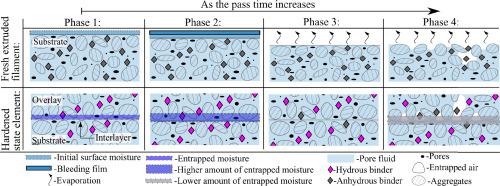Cement and Concrete Research ( IF 10.9 ) Pub Date : 2021-09-03 , DOI: 10.1016/j.cemconres.2021.106559 Gerrit Marius Moelich 1 , Jacques Kruger 1 , Riaan Combrinck 1

|
Providing additional water to the hydrating cementitious particles is essential to achieve the optimal mechanical performance of the low w/b concrete mixes preferred for 3D printing. This study incorporates superabsorbent polymers (SAP) and additional water in 3D printed concrete (3DPC) to promote the hydration process through delayed internal water release. The study shows that a retentive SAP modifies the rheological development by absorbing the pore fluid for a short period after printing. The absorption-induced stiffening increases the thixotropy and buildability by 49% and 25%, respectively. A retentive SAP increases the flexural strength and interlayer adhesion by 19% and 10%, respectively. This is due to the internal water release that promotes hydration. Evaporation of the interlayer moisture during the pass time has the opposite effect— evaporation reduces the interlayer adhesion. Based on this assumption, an analytical model is proposed. The model accounts for the pass time, bleeding, and the environmental evaporation rate to estimate the surface moisture and predict the lack of interlayer adhesion. In this study, the model accurately (RMSE = 2.5%) predicted an interlayer adhesion reduction from 30% to 50%. The interlayer adhesion results of other studies could also be predicted.
中文翻译:

用表面水分模拟 3D 打印混凝土的层间粘合强度
为水化水泥颗粒提供额外的水对于实现 3D 打印首选的低 w/b 混凝土混合物的最佳机械性能至关重要。这项研究在 3D 打印混凝土 (3DPC) 中加入了高吸水性聚合物 (SAP) 和额外的水,以通过延迟内部水释放来促进水化过程。研究表明,保持性 SAP 通过在打印后短时间内吸收孔隙流体来改变流变学发展。吸收引起的硬化使触变性和可建造性分别增加了 49% 和 25%。保持性 SAP 将弯曲强度和层间粘合力分别提高了 19% 和 10%。这是由于促进水合作用的内部水释放。通过时间期间层间水分的蒸发会产生相反的效果——蒸发会降低层间附着力。基于这个假设,提出了一个分析模型。该模型考虑了通过时间、泌水和环境蒸发率来估计表面水分并预测层间附着力的缺乏。在这项研究中,该模型准确地 (RMSE = 2.5%) 预测了层间附着力从 30% 减少到 50%。其他研究的层间粘合结果也可以预测。5%) 预测层间附着力从 30% 减少到 50%。其他研究的层间粘合结果也可以预测。5%) 预测层间附着力从 30% 减少到 50%。其他研究的层间粘合结果也可以预测。









































 京公网安备 11010802027423号
京公网安备 11010802027423号